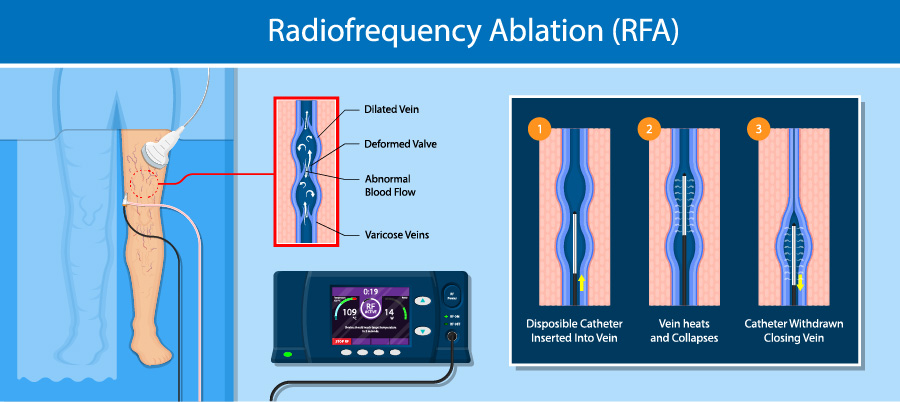Also known as: Endovenous ablation, radiofrequency ablation, venoseal (venous glue), laser therapy
Duration: About 15 to 20 minutes
An endovenous ablation is a minimally invasive procedure that is performed in a clinic setting to treat varicose veins and chronic venous insufficiency in the lower extremities/limbs. The targeted vein is treated with radiofrequency energy or venous glue (venoseal) to seal off the diseased vein and reroute the blood flow through healthy ones.

Uses:
- In varicose veins and chronic venous insufficiency which causes leg swelling and ulcers in some individuals
Preparing for the procedure:
![]() Download Pre & Post Procedure Instructions
Download Pre & Post Procedure Instructions
How it is performed:
- First, an ultrasound is performed to check for any clots in the leg veins.
- Once the vein to be treated is targeted, a local anesthetic will be given so you can relax while you remain awake during the procedure.
- With ultrasound guidance, a catheter (a thin, long tube) will be placed into a blood vessel in your leg or groin area to reach the targeted vein.
- Once the diseased area of the vein is reached, radiofrequency energy is emitted from the tip of the catheter.
- The catheter is then pulled back slowly and the heat given off from the tip of the catheter burns the lining of the vein and seals it off.
- The blood flow is redirected to other healthy veins.
- A compression stocking is given to wear once the procedure is completed.
Note: A laser may be used in place of radiofrequency but our clinic only uses radiofrequency or venous glue (venoseal).
Show references
Niedzwiecki G. Endovenous thermal ablation of the saphenous vein. Semin Intervent Radiol. 2005;22(3):204-208. doi:10.1055/s-2005-921953
Kayssi A, Pope M, Vucemilo I, Werneck C. Endovenous radiofrequency ablation for the treatment of varicose veins. Can J Surg. 2015;58(2):85-86. doi:10.1503/cjs.014914
Woźniak W, Mlosek RK, Ciostek P. Complications and Failure of Endovenous Laser Ablation and Radiofrequency Ablation Procedures in Patients With Lower Extremity Varicose Veins in a 5-Year Follow-Up. Vasc Endovascular Surg. 2016;50(7):475-483. doi:10.1177/1538574416671247
